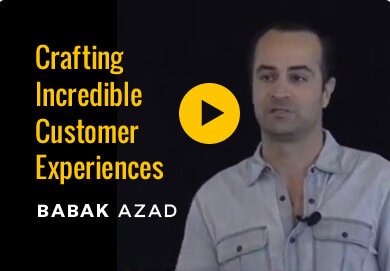Consumers love to watch experts showing off their skills. Some skills, like sports, are more mainstream than, say, being able to navigate Excel without a mouse (like your truly, ahem, ahem). Any glance at YouTube shows not merely the diversity of expert skills that exist in this world, but when looking at the view and subscriber counts of some YouTube channels, the sheer *interest* in their respective categories.
This concept shouldn’t be news to anyone who has been paying attention. But connecting the fact that consumers want to watch experts with a business’ desire to build a brand hasn’t been as pervasive as you might expect.
Why don’t more businesses tout their expertise in a demonstrable way that customers can benefit from? Why don’t they create more content – not just any content, mind you, but content showing off a level of know-how that consumers would envy? Especially when doing so would result in a more engaged customer.
When you buy a desk, it doesn’t require any expertise to use that desk. However, some products and services require, even depend upon, specialized skills and knowledge. Particularly when a product requires customers to use it to achieve a goal (whether cooking, weight loss, building something or otherwise), watching an expert apply their skills can help customers achieve their goals and can be a fun aspect of the customer experience. Or, sometimes we may not want to do-it-ourselves, but merely want to observe, enjoy, appreciate and sit back in awe of an expert.
Anytime we can get customers to spend their time watching one of OUR experts is a win. It means we have their attention, it means we are doing something of interest to them. In a very specific way, we are being of service to them. And it means that we are building a connection, positively affecting their experience with the business.
Though there are a few ways to allow customers to see an expert’s skills, the most effective is through video or an in-person demonstration.
Benihana: Fun with Cooking
Benihana restaurants have been serving and entertaining guests for over 50 years. If you’ve never been there, the basic concept is that guests sit around a teppanyaki table, which is basically a flat grill. The chef prepares the food in front of the guests, cooking up everything from shrimp appetizers to steak and seafood entrees.
Making food in front of patrons may not seem like a big deal – be that a sandwich at Subway, a salad at Sweet Greens, or sushi at Nobu. But Benihana was one of the earliest presentation-style restaurants, bringing with them an entirely new dining experience.
The big difference with Benihana was, and still is, the way their chefs interact with the customers. To start, they all have phenomenal technical skills; watching a chef at Benihana clean and cut up shrimp at the pace they do is harrowing and awe-inspiring. But it’s the real sense of entertainment they bring that is the real differentiator. We’ll see this below with Twitch, in a totally different genre like gaming, but when technical skill is matched with an engaging personality, that is when the real magic happens.
Each chef brings their own sense of flair. Some may flip the food perfectly onto a guest’s plate, others create a tower of onion rings that smokes when they pour oil into it, and some crack jokes. The goal is that Benihana is part dining experience, part theater. And when you are watching a chef wield obviously sharp knives in the manner they do, combined with a sense of flash and personality, Benihana has made a name for itself in what a dining experience can be.
I’ll say from my own experience that I’ve never left Benihana disappointed with the food. But I have left disappointed with the experience. Like every business where a certain level of personality and creativity is involved, consistency is a very difficult thing to maintain. I recall a visit to New York City where I felt so rushed that I didn’t get to enjoy the time at the table didn’t get enough time to watch the chef do his thing. Another time I had a chef that just didn’t engage with our table. It felt like the blackjack dealers in Vegas who simply deal and don’t engage with the guests; whether you win or lose (more often the latter based on the odds unfortunately), guests want to have fun playing. With Benihana, it’s the same thing.
I only mention the sense of disappointment I felt because it reflects the standards which they had previously set. Guests have a certain measure of expectations when they go to Benihana. Most of the time, their chefs nail it. It’s one of the primary “why’s” of why you go to Benihana. Guests can get great surf and turf many places. But they go to Benihana for the experience. They go to watch a chef do what they can’t. In an entertaining way.
Twitch: Watch Them Play
The gaming site Twitch shares many similarities with Benihana in the experience they both aim to craft with their respective audiences. In allowing viewers of their site to watch someone play a video game, Twitch may at first seem like the virtual equivalent of a bunch of friends playing games and hanging out on the couch. Except that it’s not simply a few friends but can be hundreds of thousands watching a single player. And just as playing at home with friends is a lot more fun when there’s a level of engagement between players, the most-viewed and followed gamers on Twitch are those who are not just great at the game but know how to engage their viewers well beyond what’s happening in the video game. What they say and how they interact with their fans is a key aspect of why fans watch some players over others.
For some context, Twitch was acquired by Amazon in 2016 for one billion dollars. As with so many things gaming these days, there’s a lot of money in this business. Currently, the top player is twenty-something Tyler Blevins, who is known to his fans as Ninja; Blevins is currently making $500,000 a month, in large part from donations that fans can make on Twitch. Not only does he show off his technical skills while playing, but he also brings an engaging personality. Ninja interacts with his audience, speaking to fans and creating a real sense of community. Twitch makes this possible.
It might seem crazy to some that so many people would sit on their phone or in front of their computer to watch someone with whom they have no direct relationship play a video game. But this misses two key points. First, many of those who are gaming fans grew up watching their friends play videogames. For them, Twitch is an entirely normal thing, albeit online rather than in person. And second, gamers such as Ninja, who are masters at games like Fortnite AND who have an engaging personality, have connected with their audience to make it feel like there is in fact a direct relationship between the two. Fans of Ninja feel like they know him and feel like they are right there with him as he’s playing.
In Twitch’s case, some viewers watch because they are fans of the game the player is in, and there’s a certain level of appreciation they have for the skill. Others just want to be entertained even though they may not fully appreciate just what level of skill is involved. Regardless, Twitch has created an immensely valuable platform where experts, both in a game and in entertainment, can draw others in at huge scale.
Home Depot: Free Classes to Help You Do-It-Yourself
Years ago, hardware stores were places where shoppers could get some of the basics, and perhaps some of the more advanced repair and construction needs. While some professionals would frequent a local hardware store, most customers were individuals wanting gear for their home or office, but primarily for more minor work. When contractors or those in construction needed to make more substantial purchases, there were stores that serviced them more readily.
And yet, if you enter a Home Depot today, it’s common to see people of all types – from those who need a basic screwdriver to a contractor buying goods for a current job to a hobbyist buying the same goods as that contractor. Do-it-yourself is not a new thing. People have been gardening, fixing dishwashers, or building decks in their homes for years.
What has changed is the number of non-professionals doing so and the scope of the projects they are tackling. For its part, Home Depot has helped with this shift by hosting classes in its stores, allowing all-comers to attend, ask questions and learn. It’s a brilliant strategy – if people understand what it is they need to do (and certainly what they need to buy) to redo, for example, the flooring in their bedroom, they’ll have more confidence. They are then more likely to purchase the equipment the need to do so, and it’s much more likely that those purchases will happen at Home Depot if the classes are there.
Sure, people can and will continue to hire contractors and handymen, so it’s possible to argue that from Home Depot’s perspective, so long as *someone* is making the purchase, they are indifferent about who that person is. But for many consumers, given that one of the largest cost buckets in this type of work is the actual labor, the difference between doing the work and not doing so may be that cost of labor. So if they can do it themselves, then those are purchases that Home Depot likely would not have gotten.
In its own way, Home Depot has developed a content strategy that brings consumers into its stores, educates them on what’s involved in a project, and then makes it simple to purchase the necessary equipment for that project.
For all the talk around content marketing, particularly in digital marketing, isn’t this what valuable content should deliver?
Home Depot experts certainly provide similar content online, but this has been a core strategy for Home Depot for years, whether offline or online.
Red Bull: Watching Others Do What Most Wouldn’t
The fact that Red Bull created an entirely new business unit, a media company, tells you a great deal about what they’ve been able to tap into. When you think about Red Bull Media Group, it’s easy to forget that Red Bull is a beverage. The Media Group is very much aligned with the overall Red Bull brand, reinforced with its original tagline, “Red Bull gives you wings.” The message Red Bull conveys through its videos is about pushing boundaries, which unifies with the theme of giving people wings.
Ultimately, though, Red Bull’s videos feature extreme athletes doing amazing things—the kinds of things most people might never attempt on their own. Customers don’t necessarily watch these experts because they intend to emulate them. Rather, they watch them to feel a sense of awe and amazement. In Red Bull’s case, there is less a sense of education or aspiration they are necessarily trying to deliver to their viewer. It is much more about entertainment. And certainly, of people doing things that represent what the brand is trying to help everyone achieve in their own way.
For its part, Red Bull’s “experts” showcase a message that supports the overall company’s brand. They are the most extreme version of what they are trying to provide, inspire and support with their customers. When you watch a Red Bull video, you can’t but feel blown away, sometimes scared. But in that moment, there’s a sense that so much more is possible. And that is a powerful feeling to deliver to people. It’s what Red Bull’s “experts” help to communicate to viewers.
Your Customers Want to Watch You
Seemingly every business should include some component of “watching an expert,” whether through in-person demonstrations or some other technique. You could be selling a product (physical or digital) that requires skill to use. There might be ancillary skills related to your product (think workout programs produced by a supplement manufacturer). Ultimately, what is the reason people are buying your product? And then what type of useful, educational, and/or entertaining content can you create to connect with their goals? However you choose to incorporate it, whether through video or in person, it will strengthen your customers’ sense of connection with your product or service.
Customers who are better connected to a business are more likely to buy again and more likely to tell positive stories to others. Each of those helps to build the business and to build the brand, both of which are two primary goals of most businesses.
Your business has experts that your customers are envious of. Show them off to your customers.







Leave a Reply
You must be logged in to post a comment.